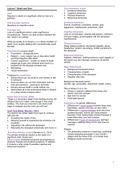Lecture 1 Death and Grief Four dimensions of grief
1. Emotional dimension
Grief 2. Cognitive dimension
Reaction to death of a significant other (or loss of a 3. Physical dimension
job/limb) 4. Behavioral dimension
Post-traumatic reactions Emotional dimensions
Reactions to impactful events Sorrow, loneliness, numbness, anxiety, guilt,
aggression, helplessness, pessimism, relief
Traumatic loss
Loss of a significant person under significance Cognitive dimensions
circumstances. There is no clear division between the Loss of concentration, lowered self-esteem, confusion,
two, there is an overlap intrusive images, preoccupation with the deceased,
hopelessness
What we usually do is trying to avoid those numbers of
death. Even people dealing with it professionally avoid Physical dimension
the topic Sleep-related problems, decreased appetite, stress,
headaches, tension, low energy, similar symptoms to
Fascination to conquer death the deceased
• Procreation – biologically seen
• Religion – every religion has an idea about death Behavioral dimension
and what happens after death Agitated, withdrawn, seeking behavior (catch signals of
• Cryonic suspension – bodies (or head) of death the person you are missing), avoidance (of painful
people get frozen and unfreeze when there is a stimuli)
medicine for the decease someone has
Major determinants
• Biohacking
• Background bereaved person
• Virtual reanimation
• Characteristics of death
Tendency to normalization • Characteristics of the deceased
• Stores where you can shop for your funeral or talk • Situation after loss
to someone
• Science where you can find information and can Background bereaved person
chat with someone – grieving for dummies Gender, age, personality, attachment, health, history
• Nimphy discuss death in small children too
Risk of dying is higher for:
• Memorialize all in the world (leave bikes or flowers
• Widow or widower (different from those who
on a place where someone dies)
haven’t lost their partner)
Kübler-Ross & Kessler (2006) • Man then for women
“Anger is a necessary stage of the healing process. Be • Early-aged groups
willing to feel your anger, even though it may seem
endless. The more you truly feel it, the more it will Explanations for gender differences
begin to dissipate and the more you will heal” • Differences in social support (women keep more
friendships, explain why they run less risks)
Grief Task Model (Warden, 1991) • Differences in coping strategies (men are more
You need to do certain tasks if you want to continue problem-focused, women are more emotion-
with your life: focused in their coping style) emotion-focused is
• Accepting the reality of loss better fitted when you lost a partner
• Allowing yourself to experience the emotions (not • Differences in types of bereavement (perhaps
avoiding) marriage is different thing it is for man than for
• Adjusting to life without the deceased women)
• Relocating the deceased emotionally and move on
Religion
A working definition of grief (Stroebe et al., 2013) • Life philosophy (systems of meaning): conflicting
The primary emotional reaction to the death of a results (opposing processes? Loss of child +
significant other (loved one). religion and the value of life, is a double loss)
It is a complex emotional syndrome accompanied by • Religious social community
physical changes and physical symptoms. In addition,
it involves a wide range of possible cognitive and
behavioral reactions
1
, Characteristics of death
• NASH classification: Natural, Accident, Suicide
and Homicide
• Sudden, untimely, intentional, painful and violent
death leads to greater risks (= underlying
dimensions)
• Debilitating and exhausting (terminal) conditions
are a risk factor too
• Talking about and acting in preparation of
imminent death predicts less intense grief
Characteristics of the deceased
• Kinship relationship (parent (lose of past), partner
(lose of present), child (lose of future), etc.)
• Nature of the relationship (peripherical or a central
relationship)
• Quality of the relationship (good relationship are
the most difficult to deal with)
Situation after loss
Lack of support, secondary losses, and ways of coping
Disenfranchised grief (Ken Doka)
= Unacknowledged losses
• Ex-partners
• In the past: miscarriage, perinatal deaths, etc.
• In some circles: homosexual relationships
• Extramarital affairs
Aspects after the loss
• Coping
• Social support
• Secondary losses
• Multiple bereavements (may trigger older griefs)
• Family dynamics that play a role (siblings not
seeing each other after death)
• Material resources (change)
Conclusions
• From a societal perspective, the concepts of death
and dying, and surviving relatives, are surrounded
by a complicated context of denial and fascination
• Death in most western societies becomes more
normalized, more than elsewhere
• The death of loved ones is virtually inescapable
and in most cultures has significant consequences
for others’ physical, psychological and social
functioning
• There is no such thing as the grieving process.
There are tremendous individual and cultural
differences. Every model is a simplification and
should be recognized as such
• Some factors lead to a higher risk of problems in
the grieving process, but the predictive power of
these factors is usually not very high, and hence
sound explanations are generally not available
• A small minority cannot cope by themselves and
need professional help
• A large majority of surviving relatives eventually
succeed in overcoming the loss
2





